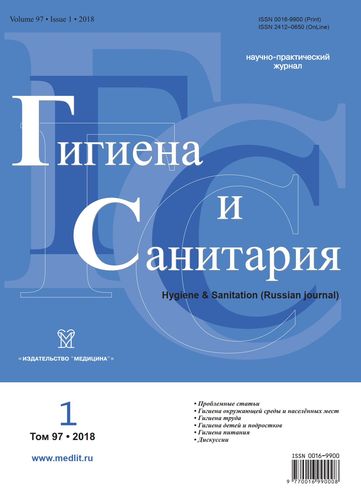Experience of methodological support and practical implementation of the risk-oriented model of sanitary-epidemiological surveillance in 2014–2017
- Authors: Popova A.Y.1, Zaytseva N.V.2, May I.V.2
-
Affiliations:
- Federal Service on Customers’ Rights Protection and Human Well-Being Surveillance
- Federal Scientific Center for Medical and Preventive Health Risk Management Technologies
- Issue: Vol 97, No 1 (2018)
- Pages: 5-9
- Section: PROBLEM-SOLVING ARTICLES
- Published: 14.10.2020
- URL: https://freezetech.ru/0016-9900/article/view/640297
- DOI: https://doi.org/10.47470/0016-9900-2018-97-1-5-9
- ID: 640297
Cite item
Full Text
Abstract
The article presents main stages of the accommodation of the Federal Service for Supervision in the field of consumer rights protection and human well-being for a risk-oriented model of control and supervision activities. The main methodological approaches to the classification of the activities of legal entities and individual entrepreneurs on the potential risk of harm to human health in the case of non-compliance with mandatory sanitary and epidemiological requirements are described. When assessing the risk, the probable frequency of violations of legislative requirements, the associated indices of potential harm to human health and the population under the influence of the surveillance facility activity were shown to be taken into account. For the tasks of the risk-oriented model, there was formed a federal register of supervisory objects, supplemented by data from all 85 regions of the country. The results of categorization of more than 630 thousand objects of supervision, data on which are included in the federal register, indicate to the share of objects of extremely high and high risk of harm to amount about 7.5% of the total mass. About 40% of the facilities do not form significant risks for citizens and can be excluded from the planned supervision, which does not exclude unscheduled inspections of their activities on the grounds established by law. The classification system is dynamic, allows lowering or raising the category of the object of supervision, depending on the results and history of inspections. The ways of the development of the risk-oriented model of supervision are determined.
About the authors
A. Yu. Popova
Federal Service on Customers’ Rights Protection and Human Well-Being Surveillance
Author for correspondence.
Email: noemail@neicon.ru
Russian Federation
N. V. Zaytseva
Federal Scientific Center for Medical and Preventive Health Risk Management Technologies
Email: noemail@neicon.ru
Russian Federation
Irina V. May
Federal Scientific Center for Medical and Preventive Health Risk Management Technologies
Email: may@fcrisk.ru
MD, PhD, Professor, Deputy Director for Science, Federal Scientific Center for Medical and Preventive Health Risk Management Technologies, Perm, 614045, Russian Federation.
e-mail: may@fcrisk.ru
Russian FederationReferences
- Order of the Government of the Russian Federation No. 1662-r «On the Concept of Long-Term Social and Economic Development of the Russian Federation for the Period to 2020». Moscow; 2008. (in Russian)
- Shepoval’nikov A.N., Mokhov D.E. On a System Strategy of Health Protection and National Preservation. Rossiya i sovremennyy mir. 2014; 84(3): 188-97. (in Russian)
- Zakharenkov V.V., Babenko A.I. Human capital and public health strategy. Sibirskiy nauchnyy meditsinskiy zhurnal. 2014; 34(1): 72-7. (in Russian)
- Velieva D.S. Ecological safety within the RF sustainable development strategy. Vlast’. 2010; 11: 36-8. (in Russian)
- Zhuravleva G.P. New trend of socio-economic development and its manifestation in the economic development strategy of modern Russia. Vestnik Mezhdunarodnogo instituta ekonomiki i prava. 2014; (1): 38-44. (in Russian)
- Nikonorov S.M. The transition from a strategy of social and economic development to the sustainable development strategy. Menedzhment i biznes-administrirovanie. 2016; (4): 28-35. (in Russian)
- Khodasevich S.G., Panchenko O.A. State regulation and support of development of the innovative enterprises in small-scale business in Russia. Nauchnoe obozrenie. Seriya 1: Ekonomika i pravo. 2012; (2): 37-48. (in Russian)
- Zhulin A.B., Zav’yalova L.D., Knutov A.V., Plaksin S.M., Semenov S.V., Chaplinskiy A.V. Updating a System of Control and Surveillance Authority in the Russian Federation: Analytical Report [Modernizatsiya sistemy kontrol’no-nadzornykh polnomochiy v Rossiyskoy Federatsii: Analiticheskiy doklad]. Moscow; 2014. (in Russian)
- Hampton P. Reducing administrative burdens: effective inspection and enforcement. Available at: http//news.bbc.co.uk/nol/shared/bsp/hi/pdfs/bud05hampton_150305_640.pdf
- Fedorenko E.V. Legal basis for risk analysis methodology while ensuring food safety in the eurasian economic union and the republic of Belarus. Analiz riska zdorov’yu. 2015; (3): 13-8. (in Russian)
- The concept of increasing the effectiveness of the control and supervision activities of public authorities and local authorities for 2014-2018: Project. Available at: http://gos.hse.ru/upload/Libv/conception.pdf (in Russian)
- WHO. Global burden of disease 2004 update: disability weights for diseases and conditions. Available at: http://www.who.int/healthinfo/global_burden_disease/GBD2004_DisabilityWeights.pdf
- Resolution of the Government of the Russian Federation No. 806 «On the application of the risk-oriented approach in the organization of certain types of state control (supervision) and amending certain acts of the Government of the Russian Federation». Moscow; 2016. (in Russian)
- Plaksin S.M., Zuev A.G., Knutov A.V., Maksimova S.I., Polesskiy E.A., Semenov S.V., et al. Control and Surveillance Activities in the Russian Federation in 2015: Analytical Report [Kontrol’no-nadzornaya deyatel’nost’ v Rossiyskoy Federatsii v 2015 g.: Analiticheskiy doklad]. Moscow; 2016. (in Russian)
- Goryaev D.V., Chernenko V.V., Tikhonova I.V., Fedoreev R.V. On the implementation of risk-oriented approach to the control and supervisory activities of Rospotrebnadzor in the Krasnoyarsk territory. Analiz riska zdorov’yu. 2016; (1): 96-102. (in Russian)
Supplementary files









